Fittings and Tubing for Ultrahigh-Pressure Liquid Chromatography
LCGC North America
To obtain the best performance from your UHPLC system, you need the right tubing and fittings. Here is what you need to know.
Given that ultrahigh-pressure liquid chromatography (UHPLC) is performed under high pressures, the design requirements of fittings, unions, tubing, in-line filters, and other supporting flow elements have become more important. This installment discusses some of the improvements made in column accessories and provides commercial examples of new products designed to meet the needs of UHPLC.
In the early-to-mid 2000s, ultrahigh-pressure liquid chromatography (UHPLC) had its beginning. Before those years, most liquid chromatographers were quite content using 5-μm particle diameter (dp) columns with 25 cm × 4.6 mm dimensions. Some were switching over to shorter 3.0- or 3.5-μm dp columns (15 cm × 4.6 mm) for faster separations. Although several companies experimented with smaller, nonporous particles, in 2003, the first silica-based, sub-2-μm totally porous particle column (Zorbax STM, Agilent Technologies) came onto the market (1). These 1.8-μm particles were packed into 2.1- and 4.6-mm i.d. columns but in short 15–50 mm lengths. These columns had twice the efficiency of the 3.0-μm dp columns but, as expected, the pressure was somewhat higher, especially if one required longer columns for more complex samples. Up to that time, high performance liquid chromatography (HPLC) systems had maximum pressure limits of 400 bar (6000 psi) and were optimized for 4.6-mm i.d. columns with 15–25 cm lengths. That all changed in the mid-2000s when system pressures began to creep up, starting at 600 bar and then up to the 1300 bar pressure that we see today. Over the latter part of the 2000s up until the new decade, the pressure race was on and at least nine companies now have systems capable of operating over 1000 bar. A new nomenclature arose: ultrahigh pressure liquid chromatography, or UHPLC, to differentiate it from HPLC. These higher upper pressure limits were rarely reached for most practical separations unless one was using very long columns operating at high flow rates. However, to handle these higher pressures new hardware had to be developed for all parts of the high-pressure system. Fittings, nuts, ferrules, unions, connectors, tubing, injection valves, pump check valves, mixers, and so on had to meet these high-pressure requirements without leaking, even after many connecting and disconnecting cycles. With the increasing interest in biochromatography, new biocompatible hardware had to be developed, also with high-pressure capability.
A major benefit of the growing use of sub-2-μm totally porous particles was the greatly increased separation efficiency. With the increased efficiency, peaks became very narrow, sometimes only a few microliters wide. Thus, the flow components from the point of injection to the detector outlet had to not only withstand the higher pressures, but needed a greatly decreased volume to minimize band spreading and the subsequent loss of efficiency and resolution. The faster separations, sometimes only a minute or two, on the smaller, high efficiency columns, also required a decrease in system dwell volume (gradient delay volume) so that the solvent gradient would reach the column inlet in the fastest possible time and the lowest possible volume. If an older instrument designed for 25 cm × 4.6 mm columns was used, the dwell volume (typically several microliters) would require too much time for the gradient solvent mixture to pass from the point of mixing to the column inlet and thus delay peak elution and sometimes the resolution of the early eluted peaks. This is equivalent to putting an isocratic hold for a period of time (dwell time), which also tends to slow down the throughput for high-speed analytical work. Fortunately, the manufacturers of UHPLC systems recognized these potential deficiencies and designed the flow components of their systems to provide lower band dispersion (although, in some cases, not enough) and to decrease dwell volume.
The introduction of small molecule, superficially porous particle (SPP) columns in 2008 (Halo, Advanced Materials Technology) provided similar efficiency to the sub-2-μm columns but at about half the pressure (2). As for instrumentation requirements, shorter versions of these columns require the same low band dispersion of the sub-2-μm dp columns, but not necessarily the ultrahigh pressures, except for very long SPP columns operated at high flow rates. Although the older 400 bar instruments provided sufficient pressure to be used with the shorter SPP columns, the band dispersion requirements often required system updating but, in most cases, couldn't provide the reduced volumes designed into the newer UHPLC instruments.
In December 2003, I wrote an article (3) entitled "How to Get the Most Out of Your HPLC Column," in which I went into details about the instrumentation requirements of the low-dispersion columns, even before sub-2-μm particles became popular and well before SPP columns came into the forefront. In those days, the small internal diameter columns of 1 mm and under had the very same low system dispersion requirements that we talk about today for the short, 2.1-mm i.d. columns for HPLC and UHPLC. In that 2003 article, some of the topics covered were
- Extracolumn volume and its effect
- Estimating the extracolumn volume of an HPLC system
- System dwell volume and its effect
- How to estimate the dwell volume of an HPLC system
- System modifications to reduce extracolumn and dwell volumes
Rather than repeating this introductory material here, I refer readers to the original publication (3).
In this column installment, my goal is to bring readers up to date on system flow components, namely tubing and fittings that have been optimized for UHPLC by decreasing extracolumn and dwell volumes and increasing maximum pressure ratings as well as new hardware designs that make the everyday job of chromatographers easier. Besides being compatible with the modern day requirements of increased pressure and decreased volume, user convenience is also a much larger consideration. Components such as hand-tightened fittings, simple-to-install guard columns, and in-line filters are all part of these new conveniences.
Importance of Extracolumn Volume in UHPLC
Just so we are all on the same page, I have reproduced two figures from the earlier article I wrote (3). Figure 1 provides a flow schematic that depicts areas of contribution to extracolumn effects and Figure 2 focuses on flow system dwell volumes, sometimes referred to as gradient delay volumes.
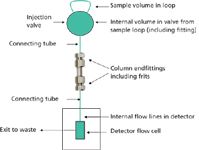
Figure 1: Extracolumn volumes in an HPLC system. The areas in green are flow-stream devices that contribute to extracolumn volume.
Extracolumn volume is the volume of mobile phase outside of the column interior that the analyte traverses as it moves from the point of injection to the detector flow cell exit. Figure 1 shows the location of these volumes in a typical LC system. The components in green indicate the areas where volume contributions can contribute to extra column effects. The variances of these volumes are additive so it does little good to minimize tubing volume but use a large flow cell volume for the detector or inject a large (50 μL) sample volume — all volumes have to be minimized. If a guard column is added to Figure 1 between the injector and the analytical column, then the variances associated with its additional volumes (connecting tubing, endfittings with frits) would be included. There are some areas that can be adjusted to improve the situation. For example, injecting a smaller sample volume or using a smaller sample loop, shortening the connecting tubing lengths, or decreasing the internal diameters of the connecting tubing all can help. On the other hand, other system components such as the needle seat capillary for autosamplers, heat exchangers, and other devices directly in the flow stream (injector to detector outlet) also need to have the smallest possible volume contributions.
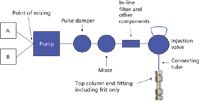
Figure 2: Dwell volume of an HPLC system with low-pressure mixing. The areas in blue represent flow-stream devices that contribute to dwell volume.
The above discussion assumes that isocratic elution is being used. For gradient work, the focusing effect negates most or some of the precolumn band spreading since the initial mobile phase solvent strength is usually low enough so as to not cause analyte band spreading at the head of the column. However, if too large of an injection volume is used and the sample solvent strength is too high, there may still be some contribution to band spreading even in the gradient case. When injection solvent or volume problems are encountered, diluting the sample with a weak solvent will often cause a decrease in extracolumn contributions upstream of the injection device. Of course, all the discussions about minimizing the post-column extracolumn volumes, including the flow cell, hold for both gradient and isocratic operation.
Tubing for UHPLC
Assuming that tubing is treated as an open cylinder, equation 1 shows that the contribution to extracolumn volume variance of a piece of connecting tubing is proportional to the tubing diameter to the fourth power as well as the tubing length. So, we can lower the band dispersion by decreasing tubing length, but even more by decreasing the internal diameter of the tubing.

where σt2 is the contribution to dispersion of the tubing, dt is the tubing internal diameter, Lt is the length of tubing, F is the flow rate, and D is the diffusion coefficient of the analyte in the mobile phase.
Table I shows some typical internal diameters that are now available from tubing, instrument, and column manufacturers. For many years, when 4.6-mm i.d. columns were the norm, instruments used 0.17-mm i.d. tubing throughout the entire LC system, before and after the column. However, when UHPLC first came along, tubing internal diameters throughout parts of the systems were reduced to around 0.12 mm. With the newer instruments, and striving to decrease band dispersion even more, manufacturers reduced the internal diameters even further as depicted in Table I. However, when tubing internal diameter is reduced two things happen: back pressure caused by the small tubing rises, especially at high flow rates and plugging becomes a real possibility from many sources (for example, mobile-phase contaminants, sample particulates, metal fragments from LC system components, and even dust). So, extreme caution should be exercised when the smallest internal diameter tubing is used for certain flow path connections. In common practice, 0.075-mm i.d. tubing is the smallest that should be used for most UHPLC applications. Another consideration when selecting a capillary tube is its outer diameter (for example, typical values are 1/8 in. [3.2 mm], 1/16 in. [1.6 mm], 1/32 in. [0.785 mm], and 0.360 mm [fused silica]), because when selecting fittings and ferrules to connect the tubing to other flow components, this dimension is of the utmost importance.
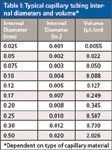
Table I: Typical capillary tubing internal diameters and volume*
The material of construction is another important consideration when selecting a capillary tube. When one thinks of LC connections, stainless steel first comes to mind since this has been the standard tubing used for decades. The 316 stainless steel tubing is quite rugged and is still the most popular for HPLC and UHPLC connections. Depending on the wall thickness, stainless steel tubing will hold up to most pressures commonly encountered in UHPLC because its burst strength is well beyond 1200–1300 bar instrument ratings. However, there are cases where stainless steel has shown some interaction with sensitive biological compounds, so some users may want to consider titanium, Hastelloy C, nickel 200, or Inconel 600. For other metals, titanium seems to have the best bio inertness for proteins and biotherapeutics of these other metal capillaries. Polyether ether ketone (PEEK)-coated fused silica is available, but its pressure rating doesn't get into the upper UHPLC region and is limited to 600 bar. Electroformed nickel tubing (Valco Instruments) is available in the smallest internal diameters indicated in Table I and possesses a mirror-like interior finish. Plain synthetic fused-silica tubing, which is quite inert and has mostly been used for capillary LC systems, is another alternative for high-pressure operations up to 690 bar (10,000 psi). Small internal diameter (0.05 mm and below) PEEK-covered fused silica is also available, can withstand pressures up to 1723 bar (25,000 psi), and has the advantage of making a good seal with many styles of fittings.
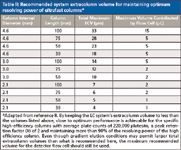
Table II: Recommended system extracolumn volume for maintaining optimum resolving power of ultrafast columns*
A new addition to the capillary arsenal is PEEK-lined stainless steel, which provides a biocompatible surface and can be bent to fit sharp bends and as sample loops for injection valves. The pressure rating of such tubing is 1200 bar when used with the proper fittings. For most of the UHPLC capillaries, the tubing should be purchased in precut lengths where the ends are smoothly cut and prepolished. Cutting your own tubing may be possible, but one must ensure that the tubing ends are perfectly flat because even small cutting errors can contribute to extracolumn effects when the tubing is plumbed into a high performance system.
The PEEK polymeric capillary tubing has been the standard for years for applications where inertness is key. In UHPLC, it can withstand pressures ranging from 34 bar (500 psi) to 690 bar (10,000 psi) depending on the tubing internal diameter and outer diameter. PEEK has also found applications on the low-pressure side of the column for connections to the detector. It is easily cut to length with a razor blade, can be easily bent, and is compatible with the most commonly encountered solvents. Fluoropolymer capillary tubing is also available for moderate-pressure operation (138–276 bar; 2000–4000 psi) for applications where chemical compatibility is important.
Some manufacturers have conveniently color-coated their various capillary tubing offerings so that users do not mistakenly use the wrong tubing for their highest pressure or smallest extra-column volume operation.
Fittings for HPLC and UHPLC
For many years, metal (usually stainless steel) compression fittings were the standard type of fitting used in the LC laboratory. The purpose of the fittings was to ensure a tight physical connection of tubing throughout the LC system. Typically, the compression fittings comprised either a two-piece design consisting of a nut and a ferrule or sometimes a three-piece design that has an extra ferrule backup. These fittings have different geometries, fit different sized tubes, have different threads on the nut, and are permanent and nonadjustable after they have been assembled. For the pressure requirements at the time, 400 bar (6000 psi), these fittings served the chromatography community well. Although chromatographers desired a standard universal fittings that were interchangeable, manufacturers came up with their own design of fittings, perhaps to keep customers locked into their products. For the various manufacturers' endfittings, the male stainless steel nuts vary in overall length and thread length. For UHPLC use, stainless steel fittings can generally withstand the pressures generated by most LC instruments.
Stainless steel fittings are still the most popular since they are inert and have good high-pressure holding abilities. For the fitting design to seal properly, the ferrule portion of the fitting must be permanently attached (sometimes referred to as "swaged" based on the Swagelok fittings used in gas chromatography [GC] and LC applications) to the tubing it is connecting. Improperly made connections can be a big problem when working with high-pressure or low-dispersion chromatographic systems. Let's take a look at the potential problems that can exist when improper fittings are used together or when proper fittings are improperly swaged.
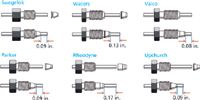
Figure 3: Typical stainless steel fittings used in LC.
Figure 3 depicts different manufacturers' hardware designs for column endfittings and other tubing connections. The drawing in Figure 4c shows the male portion, in which the ferrule is of a conical design that then lines up perfectly with the female conical portion (4). With the exception of the Swagelok design, which consists of three individual pieces, all of the other designs use a two-piece configuration. As one can infer from the different examples, the stem length, which is the length between the bottom of the ferrule and the end of tubing, needs to be perfectly matched for a good seal to be made or to avoid dead volume. Figure 4a shows that if the stem length is too long, the ferrule will not seal properly and leakage will occur. For example, a Waters male fitting used with a Valco female may appear to "fit" since the threads are alike, but when put under high pressure a leak may result. If the stem length is too short, a dead volume will be created, resulting in deterioration of peak shape, lower resolution, and potential carryover (Figure 4b). Thus, a Parker male nut–ferrule combination should easily screw into a Rheodyne fitting, but a 0.08-in. gap would be present, leading to a small mixing chamber. Figure 4c shows a perfect match, and that is what is required for the best chromatographic performance. To keep the dead volume between the end of the tube and the receiving port absolutely at zero, it is still best to use the same male–female connections repeatedly and not try to use another fitting (male or female) that is not made with the same connector.

Figure 4: Ensuring the proper match of LC fittings: (a) stem length too long, (b) stem length too short, and (c) properly fitted tubing.
IDEX Health and Science, a manufacturer of HPLC and UHPLC components, recommends the following procedure for making the best connection (5):
Place the nut and ferrule, in that order, on the tubing. Place the loosely assembled fitting into a mating port, and tighten the nut finger tight. While ensuring the tubing is bottomed out inside the mating port, tighten the nut with a wrench an additional 3/4 of a turn. The ferrule should now be permanently attached to the tubing.
After many connects and disconnects of the stainless steel fittings, eventually the fitting combination must be redone. Since the ferrule is now permanently attached to the stainless steel tube, to make a new connection, the tube must be cut above the metal ferrule ensuring that the tubing end is cut clean with no ragged edges. Then a new ferrule must be reconnected to the tube and the above process repeated to ensure no dead volumes are created.
Another problem that exists for conventional swaged fittings used in UHPLC is over-tightening with a wrench. Many users feel that to ensure the best seal at these higher pressures, it is important to overtighten the fitting. However, such over-tightening can result in the ferrule getting stuck in the column permanently and may even end up causing the fitting to leak by galling the receiving port surface (6).
As requirements change, stainless steel gave way to fittings and tubing of other materials such as polymer (for example, PEEK) or mixed polymer–metal combinations. For the high-pressure end of the system (that is, before the column), combining PEEK ferrules with metal tubing or PEEK tubing with metal ferrules makes the fitting reusuable because the ferrule is not permanently connected to the tubing. However, in some of these combinations, potential problems when using UHPLC fittings have been reported (6). Tubing slippage can occur with ultrahigh pressures (>1000 bar), especially if those pressures are coupled with the pressure cycling that might occur with an injection valve. The ultrahigh pressures and pressure cycling can cause the conically shaped fittings to work harder to hold the tubing against the bottom of the receiving port while the high-pressure fluid works to drive the tubing away from the bottom of the receiving port. The result is a slight slippage and potential creation of a dead volume. Sometimes this slippage is not easily detectable since there is no leak developing nor loss of pressure. It has been reported (7) that when using metal ferrules with PEEK tubing during the tightening of the metal ferrule, the softer polymer tubing will be compressed giving rise to a noticeable increased pressure drop since the internal diameter of the tube will be slightly decreased. If the metal ferrule is tightened and untightened several times, the back pressure may increase more. This phenomenon can also occur with certain stainless steel fittings if they are strongly overtightened (6). On the low-pressure side of the system (that is, post-column), biocompatible PEEK nuts and ferrules can be used without worry.
To solve some of the problems noted with conventional HPLC fittings when UHPLC is used, new types of fittings have been developed. One of the developments was the introduction of finger-tightened fittings that negated the worry about over-tightening with a wrench and were more convenient to use than conventional fittings. Early finger-tightened fittings were somewhat limited, with upper-pressure limits that were generally lower than the maximum pressure limits of UHPLC systems (1300 bar, 19,000 psi), in the range of 6000–8000 psi. However, some finger-tight designs allow the use of wrenches that give them capabilities of 20,000 psi and above, but strict guidelines on the amount of torque that can be applied must be observed. Some of the finger-tightened fittings, which are further tightened with wrenches, often have to be retightened during high pressure usage and potential leakage has to be checked every time after reconnection. Nevertheless, because of their convenience, finger-tightened fittings have become more widely accepted since not everybody is working at the upper end of their UHPLC instrument's pressure capabilities.
Some novel designs of ferrules have overcome ultrahigh-pressure problems such as tube slippage and tube compression. For example, the VHP series of fittings (Upchurch Scientific, division of IDEX) are removable fittings that consist of a stainless steel nut, an interior stainless steel back ferrule, and a front ferrule of PEEK. The fitting has been designed to prevent tubing slippage and tubing compression when wrench tightened. The polymer ferrule provides an excellent seal with the receiving port and thus cannot cause any undue deformation or galling. The fitting can be reused throughout the flow path without losing tightness. A similar high-pressure fitting called the Tri-Fitt is available from JM Science. It also consists of three parts: a stainless steel nut, a stainless steel triangular ferrule, and a front ferrule that is constructed of carbon and PEEK. The carbon–PEEK ferrule deforms when the stainless steel nut is tightened and the stainless steel triangular ferrule clamps the tubing at the same time to increase the sealing pressure. The stainless steel parts are reusable but the front ferrule must be replaced when the fitting is removed or loosened. The fitting is rated to 20,000 psi. Analytical Sales and Services offers a three-piece push and lock system where the tube holding function and the sealing function are separate. Two finger-tight adjustments allow the sealing pressure to be applied to the ferrule and tubing independently and eliminates tube slippage. Their fitting system is rated to 27,000 psi.
The Waters gold column stabilizer reusable fitting (Figure 5) is a single-piece device that consists of a PEEK ferrule at the bottom and a long tapered collet that locks onto the capillary tube and also prevents destruction of the tubing sleeve. The collet can be released from the nut using a flat wrench and placed on another column. The PEEK ferrule should be replaced when the tubing is transferred to another column or other flow device.

Figure 5: Waters column stabilizer reusable fitting.
Some new designs for finger-tight high-pressure connections have come onto the market. The oldest is the EXP product line of Optimize Technologies. This product line consists of an entire family of high-pressure chromatography products based on patent-pending titanium-PEEK hybrid ferrule single piece designs that offer finger-tight connections to 8700 psi and wrench-tight to connections 20,000+ psi. The nut and ferrule, pictured in Figure 6a, adjusts to any 10–31 port depth and can be removed and reused in a different port while still maintaining its adjustability. It fits into the EXP fitting system with either a knurled nut (finger-tight) or a hex nut (for wrench-tight). The company also offers the EXP fitting design on its guard columns, in-line filters, and trap columns. A companion product, the EXP Ti-lok ferrule (Figure 6b), features a two-stage locking mechanism for PEEK-clad or sleeved fused-silica tubing. The reusable fitting features an autoadjusting titanium hybrid ferrule that seats in any port. The titanium locking mechanism, similar in design to those three-piece systems described above, provides a second grip point to even the pressure load over the tubing and not crush the fused silica. This fitting has a 15,000 psi rating.

Figure 6: Optimize Technologies EXP high-pressure fittings: (a) EXP hand-tight nut and titanium hybrid ferrule and (b) Ti-lok fitting.
Another new entry is the Thermo Fisher Viper finger-tight fitting for HPLC and UHPLC. With a maximum rating to 17,400 psi (1200 bar), the fitting, pictured in Figure 7, is available for both a conventional size capillary (1/32 in. o.d.) and a nano size for fused-silica and sleeved PEEK connections. A unique feature of the Viper fitting is that it uses no ferrules and thus reduces the dead volume of any fluidic connection to virtually zero. It can be used with any HPLC and UHPLC column or valve.

Figure 7: Thermo Fisher Scientific Viper fitting for UHPLC.
The newest entries into the UHPLC fitting arena are the Agilent A-line Quick Connect fittings. There are two novel types of fittings in this product line. One is a spring-loaded finger-tight fitting for various fluid connections, which seals up to 600 bar but with a wrench up to 1200 bar. This fitting could be used for column inlet or outlet, valve, and other flow stream connections. The second is a unique lever-actuated, finger-tight fitting designed primarily for column connections, but that is capable of 1300 bar operation without the need for a wrench. Both of the fittings are considered bioinert. A schematic of the finger-tight, high-pressure, spring-loaded quick connect design is shown in Figure 8. The spring-loading constantly pushes the tubing against the receiving port, delivering a reproducible connection with no dead volume. In the advanced, lever-actuated version, the spring assembly including the lever applies a constant force that presses the ferrule onto the tubing so that tubing slippage is prevented. The stem length of the fitting is adjustable and makes the fitting compatible with all types of HPLC and UHPLC columns. Little force is needed to tighten the fitting to 1300 bar (18,850 psi) without the need for any tools. One merely has to hand-tighten the column nut until feeling the first resistance and subsequently depress the lever. The fitting has been tested for reusability and robustness by disconnecting and reconnecting 200 times with no leakage nor a change in chromatographic performance.

Figure 8: Schematic of an Agilent A-Line Quick Connect fitting for HPLC and UHPLC.
Additional Flow Stream Connections
Besides the tubing and fittings for UHPLC, there are many other areas where high-pressure and low-dead-volume capabilities are also needed but, in general, the connections use the same fittings as described above. For example, not shown in Figure 1 were devices such as guard columns, connectors, in-line filters, switching valves, injection valves, autosampler needle seat capillaries, and heat exchangers all of which contribute to extracolumn volume and require optimization.
So, What's the Bottom Line?
If extracolumn volume is plaguing your HPLC or UHPLC operation, there are measures that you can take to decrease its contribution to your column efficiency. Although not a subject here, in an earlier paper (1), I discussed other instrumental parameters like data rates that can be increased so you get a sufficient number of data points across the sharp peaks of today's columns. Modern UV and diode-array detectors are plenty fast and shouldn't present a problem in affecting peak shape.
In this installment, I discussed the advances in tubing and endfitting designs that have helped to cut down on extracolumn contributions as well as withstand the high pressures generated by UHPLC instruments and columns. To put the volume considerations in perspective, I have adapted a table published by MacMod Analytical that provides some rough guidance of the total maximum extracolumn volume that can be tolerated for today's column dimensions and high efficiency performance expectations (8). It is easy to see from this table that for the larger bore, longer columns (100 mm × 4.6 mm) one can tolerate more extracolumn volume than more-typical narrow-bore, shorter columns (50 mm × 2.1 mm), which can tolerate almost no extracolumn volume without affecting optimum performance.
To summarize, here is a list of the steps that can be taken to decrease your extracolumn volume in UHPLC if your results are being affected:
- Replace capillary tubing for all connections that the sample passes through with smaller internal diameter tubing of shorter lengths.
- Replace older high-volume endfittings with lower-volume, ultrahigh-pressure fittings discussed in this article.
- Use a smaller-volume flow cell than your present one.
- Reduce sample volume to the minimum amount to have acceptable peak response.
- Reduce the sample solvent strength relative to the mobile phase strength; dilute your sample with a weaker solvent than your mobile phase.
- If using a column compartment with a heat exchanger, replace it with a lower volume version or eliminate it, if you determine that it doesn't affect your results.
If your dwell volume (gradient delay volume) is too high and affecting your peak shape or retention times, consider these options:
- Use a high-pressure gradient system (post-pump) versus a low-pressure gradient system (gradient forms of low-pressure side of pump); eliminates entire pump volume from dwell volume.
- Reduce all tubing lengths and internal diameters after the point of mixing and the head of your column.
- Use a smaller-volume mixer or no mixer at all unless this affects your reproducibility or baseline.
- If you system still has a pulse damper, you may be out of luck!
- Minimize the volume of any precolumn or in-line filter before the injector; filter your mobile phase and eliminate the in-line filter.
References
(1) R.E. Majors, LCGC North Am. 21(3), 240–257 (2003)
(2) R.E. Majors, LCGC North Am. 26(), 238–253 (2008)
(3) R.E. Majors, LCGC North Am. 21(12), 1124–1133 (2003)
(4) T. Li, D.Zeko, and M. Fuehrer, "Optimizing HPLC and UHPLC Performances with Agilent A-Line Quick Connect Fittings" presented at Analytica 2014, Shanghai, China, 2014.
(5) http://webstore.idex-hs.com/TechInfo/hplcFittings.asp.
(6) Whitepaper, "Troubleshooting UHPLC Connection Challenges," www.idex-hs.com.
(7) E. Rogatsky, B. Shaynah, M. Cai, and T.S. Daniel, J. Chromatograph. Separat. Techniq. 4(7), 1–3 (2013). Available at: http://omicsonline.org/2157-7064/2157-7064-4-193.php?aid=16515.
(8) www.mac-mod.com/pdf/technical-report/MMA084-ReduceECV.pdf.
Editor of Column Watch:
Ronald E. Majors is the editor of "Column Watch," an analytical consultant, and a member of LCGC's editorial advisory board. Direct correspondence about this column to lcgcedit@lcgcmag.com

Ronald E. Majors

Perspectives in Hydrophobic Interaction Temperature- Responsive Liquid Chromatography (TRLC)
TRLC can obtain separations similar to those of reversed-phase LC while using only water as the mobile phase.

.png&w=3840&q=75)

.png&w=3840&q=75)



.png&w=3840&q=75)



.png&w=3840&q=75)





